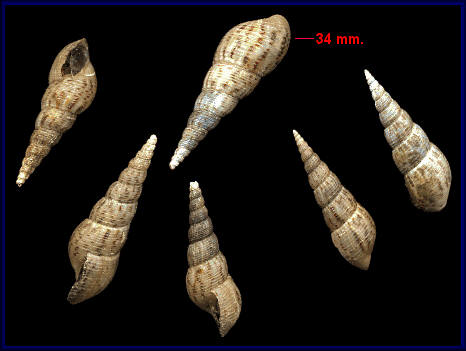Melanoides tuberculatus
Red-rim Melania
Synonym(s):
Class: Gastropoda
Order: Neotaenioglossa
Family: Thiaridae

Photographer: Bill Frank
Source: http://nas.er.usgs.gov/queries/FactSheet.aspx?speciesID=1037
Description
The red-rim melania (Melanoides tuberculatus) has a conical shell, with up to 10 whirls, and measures 40-80mm in length. An operculum is present, with a light brown to white shell and sand to dark brown markings. This snail is nocturnal, and buries itself beneath stones or decaying plant matter during the day.
Ecological Threat: Red-rim melanias are a threat to native snail populations by out-competing for resources. The red-rim melania is also a known intermediate host for a trematode parasite that completes its life cycle in the endangered fish fountain darter (Etheostoma fonticola). Further, the red-rim melania is a known intermediate host for other parasites that infects humans, such as the Chinese lung fluke (Paragonimus westermani).
Invasive snail, parasite threaten Central Texas fish stocks (article)
Biology: Breeding occurs parthenogenically and internally (the offspring is an exact copy of the parent and there is no gender differentiation needed). More specifically, this species does not spend the energy needed to form to different genders defined by reproductive organs.
History: The red-rim melania has been popular in the aquarium trade for several years. It is believed to have been introduced accidentally in the 1930's and since spread to become established within the United States.
Habitat: This aquatic snail prefers water temperatures ranging from 18-32 degrees Celsius. It has been determined experimentally that 50 degrees Celsius is lethal to the red-rimmed melania. It is commonly found in turbid (cloudy), calm and shallow water. The red-rim melania is known to feed on micro-algae and detritus.
Distribution
Native Origin: Northern Africa to Southern Asia
U.S. Present: AZ, CA, FL, HI, ID, LA, MN, NC, NV, OR, SD, TX, UT, and WY.
Texas: San Solomon Spring (Balmorhea State Park), Diamond Y Spring (15 mi north of Ft. Stockton), San Felipe Creek (Del Rio), Los Moras Creek (Bracketville), Santa Ana National Wildlife Refuge, Lake Edinburg, Delta Lake, Oxbow Pond (Brownsville), San Antonio River (San Antonio), San Marcos River (San Marcos), Old Mill Spring (Austin), and Comal River (New Braunfels)
Management
It is important to rinse fishing, boating, and other water equipment before leaving a sight. This action prevents the spread of this species to other locations. Early detection and prevention are keys methods of management for this snail. It is believed to have been established in Texas since 1960 and prevention of further establishment is important.
References
Benson, A. J.. 2012. Melanoides tuberculatus. USGS Nonindigenous Aquatic Species Database, Gainesville, FL.
http://nas.er.usgs.gov/queries/FactSheet.aspx?speciesID=1037 RevisionDate: 4/24/2006
Mitchell, Andrew J., and Thomas M. Brandt. 2005. Temperature tolerance of Red-rim melania (Melanoides tuberculatus), an exotic aquatic snail established in the United States. Transactions of the American Fisheries Society 134(1): 126-131.
Mitchell, Andrew J., Melissa A. Hobbs, and Thomas M. Brandt. 2007. The effect of chemical treatments on red-rim Melanoides tuberculata, an exotic aquatic snail that serves as a vector of trematodes to fish and other species in the USA. North American Journal of Fisheries Management 27(4): 1287-1293.
Mitchell, Andrew J., and Thomas M. Brandt. 2009. Use of ice-water and salt treatments to eliminate an exotic snail, the red-rim melania, from small immersible fisheries equipment. North American Journal of Fisheries Management 29(3): 823-828.
Mitchell, Andrew J., Robin M. Overstreet, Andrew E. Goodwin, and Thomas M. Brandt. 2005. Spread of an exotic fish-gill trematode a far reaching and complex problem. Fisheries 30(8): 11-16.
Internet Sources:
www.itis.gov
http://www.galvbayinvasives.org/Guide/Species/MelanoidesTuberculatus
 Texas Invasive Species Institute
Texas Invasive Species Institute